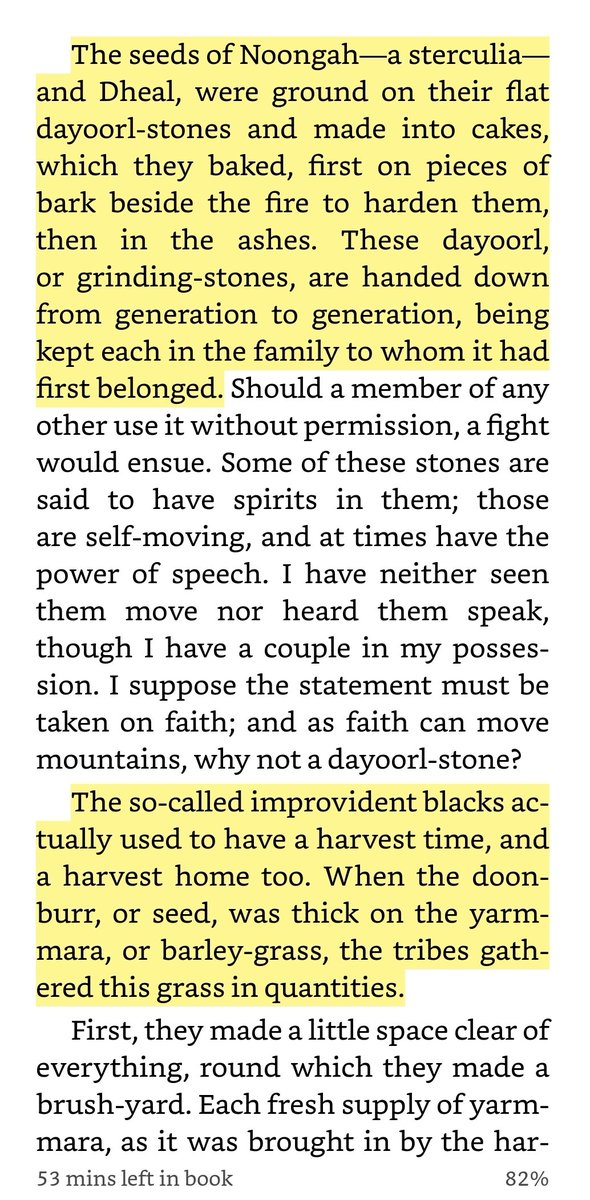This is fascinating.
But it& #39;s worth remembering some of the earliest evidence of agriculture *anywhere in the world* is at Papua New Guinea& #39;s Kuk Swamp, which was part of the Australian landmass for most of the time Indigenous people have lived here. https://www.bbc.com/news/amp/world-australia-53746652?__twitter_impression=true">https://www.bbc.com/news/amp/...
But it& #39;s worth remembering some of the earliest evidence of agriculture *anywhere in the world* is at Papua New Guinea& #39;s Kuk Swamp, which was part of the Australian landmass for most of the time Indigenous people have lived here. https://www.bbc.com/news/amp/world-australia-53746652?__twitter_impression=true">https://www.bbc.com/news/amp/...
So in some ways the unique aspect here is not "Indigenous Australians practiced agriculture thousands of years ago", but "the agricultural practices we know Indigenous Australians have practiced for ~10,000 years were also present in the Torres Strait".
There& #39;s some odd and surprising genetic evidence suggesting that Papuans and Aboriginal people didn& #39;t have much contact with each other for most of the eons they shared this continent, but this is all part of the story of Indigenous occupation and cultivation of this land.
Obviously, read Bruce Pascoe for more on this. IMO we over-value the aspects of Indigenous agriculture that resemble European agriculture -- wall-building in the Torres Strait, swamp-draining at Kuk -- and under-value those that don& #39;t, such as fire agriculture.
There& #39;s no question that Indigenous people have for tens of thousands of years transformed the Australian landscape via fire — making more grasslands suitable for growing kangaroo grass, for instance — and then turned those grass seeds into storable flour.
You couldn& #39;t publish an academic paper with evidence of *that* because it& #39;s simply something that everyone knows.
It& #39;s a rhetorical choice with large political implications that we choose to exclude these practices from "agriculture".
It& #39;s a rhetorical choice with large political implications that we choose to exclude these practices from "agriculture".
And yes, I totally fell into using that framing at the top of this thread.  https://abs.twimg.com/emoji/v2/... draggable="false" alt="😳" title="Errötetes Gesicht" aria-label="Emoji: Errötetes Gesicht">
https://abs.twimg.com/emoji/v2/... draggable="false" alt="😳" title="Errötetes Gesicht" aria-label="Emoji: Errötetes Gesicht">
Just "hunter-gathering"  https://abs.twimg.com/emoji/v2/... draggable="false" alt="🙄" title="Gesicht mit rollenden Augen" aria-label="Emoji: Gesicht mit rollenden Augen">
https://abs.twimg.com/emoji/v2/... draggable="false" alt="🙄" title="Gesicht mit rollenden Augen" aria-label="Emoji: Gesicht mit rollenden Augen">
This is in Yuwalaraay country, from Katie Langloh Parker, "The Euahlayi Tribe" (1905)
This is in Yuwalaraay country, from Katie Langloh Parker, "The Euahlayi Tribe" (1905)

 Read on Twitter
Read on Twitter This is in Yuwalaraay country, from Katie Langloh Parker, "The Euahlayi Tribe" (1905)" title="Just "hunter-gathering" https://abs.twimg.com/emoji/v2/... draggable="false" alt="🙄" title="Gesicht mit rollenden Augen" aria-label="Emoji: Gesicht mit rollenden Augen">This is in Yuwalaraay country, from Katie Langloh Parker, "The Euahlayi Tribe" (1905)">
This is in Yuwalaraay country, from Katie Langloh Parker, "The Euahlayi Tribe" (1905)" title="Just "hunter-gathering" https://abs.twimg.com/emoji/v2/... draggable="false" alt="🙄" title="Gesicht mit rollenden Augen" aria-label="Emoji: Gesicht mit rollenden Augen">This is in Yuwalaraay country, from Katie Langloh Parker, "The Euahlayi Tribe" (1905)">
 This is in Yuwalaraay country, from Katie Langloh Parker, "The Euahlayi Tribe" (1905)" title="Just "hunter-gathering" https://abs.twimg.com/emoji/v2/... draggable="false" alt="🙄" title="Gesicht mit rollenden Augen" aria-label="Emoji: Gesicht mit rollenden Augen">This is in Yuwalaraay country, from Katie Langloh Parker, "The Euahlayi Tribe" (1905)">
This is in Yuwalaraay country, from Katie Langloh Parker, "The Euahlayi Tribe" (1905)" title="Just "hunter-gathering" https://abs.twimg.com/emoji/v2/... draggable="false" alt="🙄" title="Gesicht mit rollenden Augen" aria-label="Emoji: Gesicht mit rollenden Augen">This is in Yuwalaraay country, from Katie Langloh Parker, "The Euahlayi Tribe" (1905)">
 This is in Yuwalaraay country, from Katie Langloh Parker, "The Euahlayi Tribe" (1905)" title="Just "hunter-gathering" https://abs.twimg.com/emoji/v2/... draggable="false" alt="🙄" title="Gesicht mit rollenden Augen" aria-label="Emoji: Gesicht mit rollenden Augen">This is in Yuwalaraay country, from Katie Langloh Parker, "The Euahlayi Tribe" (1905)">
This is in Yuwalaraay country, from Katie Langloh Parker, "The Euahlayi Tribe" (1905)" title="Just "hunter-gathering" https://abs.twimg.com/emoji/v2/... draggable="false" alt="🙄" title="Gesicht mit rollenden Augen" aria-label="Emoji: Gesicht mit rollenden Augen">This is in Yuwalaraay country, from Katie Langloh Parker, "The Euahlayi Tribe" (1905)">


